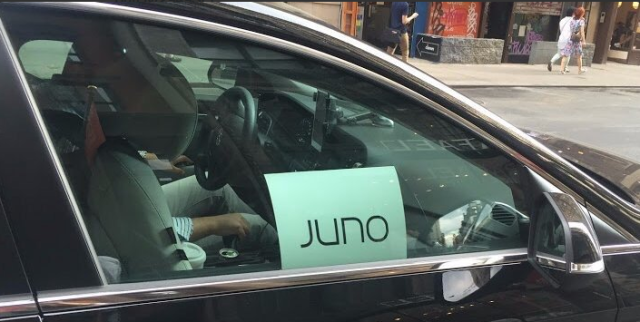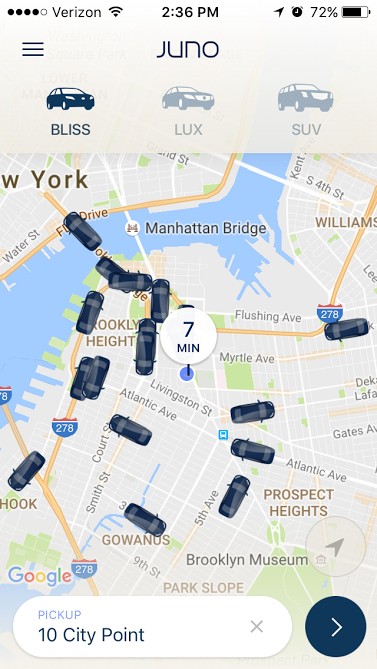
When the car service app Lyft came to New York there were a number of people (myself included) who never thought they’d make a dent. Uber, that aptly named behemoth, was already a staple in most boroughs, especially in Brooklyn where, before green taxi cabs were lining the streets, private car companies like Arecibo and Evelyn were the best option to get around. Uber, “Everyone’s Personal Driver,” was just a few taps of the iPhone away, with an approximate arrival time, payment linked directly to your credit card and no worry that your pickup might be intercepted by a roving black car with a CB radio. Now, even with competitors like Lyft, Gett, Via and Way2Ride increasing in popularity, Uber has an estimated 35,000 drivers in New York alone and is making plans to put more on the road. Yet again, it would seem impossible for any new app to make a dent with riders who already have their share of options. But, what if a company was going after drivers first and riders later?
A new company called Juno, which launched its beta app model earlier this year, is trying to do just that. It avoided the traditional route of marketing to riders first; instead, reached out directly to drivers from Uber and Lyft to join the company and help build the customer rolodex from the ground up. And with a lower commission and other perks, it seems to be working.
“Uber is losing drivers. I am working with [Uber] only to pay my lease,” one driver told me, “Once I hit $400 for the week, I turn off the app” and turn on Juno.
While other ride share app companies have found success following Uber’s lead, none have been able to actually siphon off drivers for good. So, is Juno the company that could finally push Uber out? Drivers seem to think so.
“We want to make sure that drivers feel like true partners in the company, and not just our employees.” – Keren Kessel, Juno’s marketing manager |
I first heard about Juno from a driver I met during a car ride I had taken through Lyft. Stuck in traffic my driver and I began chatting about his experience with Lyft and other car services he’d worked for (Uber, NY Taxi company, private limo services) when I asked which he preferred he mentioned that Juno had reached out to him, but that he’d been happy to stay with Lyft and Uber for the time being. The next time was also from a driver, during an Uber ride, who asked me if I was interested in signing up for the Juno beta app. By the third time a driver told me about Juno it seemed like the company was worth looking into. Why were drivers are so enthusiastic about this new app?
The obvious answer: Money. Right off the bat, the numbers work in favor of the drivers. Juno takes about 10 percent of the ride fare as commission, a third of the commission when compared to the larger ridesharing apps. Uber and Lyft each take between 25 percent to 30 percent per ride, most of which is taken as a direct commission. And although some smaller companies have been able to reduce the price of commission, the closest in line is the newish app Gett with 15 percent, no one has matched what Juno is offering drivers. And it doesn’t stop at the commission.
One of the things all of the drivers I spoke with mentioned was the 24-hour customer service line. The service line is there for drivers and passengers, in case of app error, changed location or any issue that may arise. Keren Kessel, marketing manager at Juno, told me the service line is an integral part of the company’s larger effort to include drivers in the process of growing the app. While all apps usually have a help page for frequently asked questions, only Juno and Gett so far have a way for drivers and passengers to get in immediate contact with a customer service rep.
________

“We want to make sure that drivers feel like true partners in the company, and not just our employees,” she told me.
So, is it working? It’s certainly off to a good start. While the company only recently switched their app from invite-only to open model, Juno passed the one million rides mark in late August despite only being available in New York, arguably the most saturated of all car-app markets (Uber, by comparison, handles about two million rides per month). The company already got a write up in the New Yorker’s money issue for its efforts to exploit Uber’s weaknesses on driver satisfaction and public perception.
________
As a rider, the Juno experience is pretty comparable to the bigger platforms. There might be a slightly longer wait for a Juno driver but the difference is negligible in busier areas. The cost is about the same to riders, but Juno doesn’t do surge pricing so riders can avoid paying upwards of 80 percent more than usual because you need a car at 4pm. Juno also encourages riders to share their feedback directly through the app or service line, whether about a current trip (such as needing a car with space for a stroller) or the overall experience. Juno doesn’t have a “pooling” program to share rides, which drivers told me they liked.
While lower commissions and 24-hour service line are great benefits to their drivers day to day, the big thing that sets Juno apart from other ridesharing apps is the equity structure offered to drivers. While other ride apps provide drivers with weekly bonuses once certain goals are met (usually involving their “ride acceptance” rate during peak travel times) Juno offers drivers a chance to actually buy shares of the company they’re working for.
Juno aims for its drivers to own 50 percent of the company’s founding shares in 10 years. The ultimate payoff for drivers? Investing in a company so they could keep earning money even if driver jobs become obsolete.
“Driverless cars are coming.” Kessel says, “We want [our drivers] to be able to enjoy the fruit of their labor when that happens.”
________

It hasn’t been a great year for the larger companies. After they fought against contract drivers forming a union, shut down operations in Austin after a referendum vote demanded greater driver background checks, were hit with reports of sexual harassment and assault by drivers and suffered substantial financial losses reported earlier this year, many riders were already turning away from Uber and Lyft. Identifying as the more socially conscious platform, Juno has been able to market both to riders and drivers that they’ve seen what’s happened with these bigger companies and they’re not going to make the same mistakes. A lot of drivers have signed on based on that promise.
But for some drivers, leaving Uber entirely isn’t an option because they’re taking advantage of the service to help pay off their cars.
During my research, I spoke with three different drivers who worked for both Uber and Juno. They cited Juno as their main source of income, but only after earning enough money with Uber to make their weekly lease payment to Xchange Leasing LLC, a leasing and credit company owned by Uber. Xchange started out as a small leasing program for would-be drivers to finance a car with Uber as their guarantor; it expanded this year after Uber received a $1 billion dollar loan from Goldman Sachs and sealed a partnership with Toyota. Now, Uber is a one-stop shop for leasing cars to drivers who would otherwise be considered too “risky” to qualify for a lease.
Still with me? Let’s put it in layperson’s terms. Say you want to work for Uber, but your credit is shit or less than shit. There’s no auto dealership that will lease you a car because their financing companies have no reason to believe you will make the monthly payments. However, Uber will finance a lease on a Toyota for you, and deduct the payments from your weekly earnings. Works out for everyone, right? You get a car and a way to make money, and Uber has another driver to put on the road to keep their company expanding.
Shady @Uber. You claim surge pricing is based on demand. Caught in lies. Glad we have @juno in NYC as competitor now. pic.twitter.com/dYIwJBhPap
— Jason Noble (@jnobleband) October 11, 2016
But your weekly payments are higher than average because you have bad credit, plus the payments for your lease are made to Uber after they’ve already deducted their 30 percent commission on each ride. The estimated average weekly cost of leasing a 2013 car through Uber is about $130 (compared to $96 for a 2016 model from a regular lending company). So what could have been a $400 a month lease is now almost $700 a month through Uber. And don’t forget, you’re still going to owe freelancer taxes come April because you’re not technically an employee of Uber.
For drivers who have higher-than-average weekly payments and a customer rating high enough to work for Juno, the math lays out pretty plainly. Get a car through Uber, make money through Juno, as the driver I mentioned before the jump is doing. And if that weren’t enough, drivers who are taking the risk by working primarily for Juno could see that pay back dividends long-term.
Uber’s press team did not return requests for comment, but Rachel Holt, Uber’s head of North American relations, told the New Yorker the company was skeptical whether Juno’s low commission rate would last, and that offering stock options may turn out to be legally problematic.
“I’d be very surprised if a 10 percent commission is going to continue for a long time, if ultimately a business is there to be sustainable,” Holt told the magazine. “Look, if there’s something we can learn around a different way to approach that, we would love to assess how that works. If there’s something very compelling in what they’re offering to drivers, we want to continue to learn from that.”
_______

Ultimately, as the New Yorker story points out, Juno may be doomed anyway. This could be seen like a company trying to perfect the mp3 download on the eve of the debut of Spotify and other streaming services.
“A world of driverless cars could pose a far greater threat to Uber than Juno’s kinder-copycat strategy,” Sheelah Kolhatkar writes in the magazine. “It could take any number of forms, from a subscription model, where consumers pay an annual fee to have access to an autonomous car whenever they need it, to a system more like Zipcar, where people pay on a per-use basis. Car sharing or fractional ownership could become widespread. Considering the number of possible arrangements, there’s no reason to assume that any of today’s ride-summoning firms will be dominant forces in an era without drivers”
Cancelled a ride with a driver on Juno because he was too far away. Dude has the nerve to accept my ride on Uber. What the hell is happening
— 🙆🏾♀️ (@jadesfw) October 7, 2016
Whether Juno’s strategy of attracting drivers first and riders second will put them in the same league as Uber remains to be seen. As a new company they’ve had the opportunity to learn from Uber’s mistakes and attempt to course correct on what they’ve already seen the bigger companies do. But in terms of living up to their motto “Happy Drivers, Happy Riders” they seem to have the first part figured out.
Follow @KatyHartnett for more updates about Juno and other emerging apps.
4 Comments
Leave a Reply




Juno does actually have surge pricing, but it’s very upfront about it. I received a notification this weekend telling me that I would be charged 10% more on my ride due to lack of availability (or something comparable) unless I wanted to wait two minutes to try again.
It’s about time there’s a company that cares about their employees and not just themselves piling up the cash into a big mountain and leaving all their drivers behind Juno cares about their drivers and in doing so will ultimately be a better ride service for all concerned
Good points. I’ve been an Uber driver for years and I’ve witnessed how Uber changed as the time goes by. New York City is a good place to drive whether Uber, Lyft or Juno. I was actually thinking of switching to Juno and it was explained well in this article why I should. Thanks for sharing.
1,ve been driving with uber since 2014
Before I started to. Register on line . I,ve seen on uber side advertising I can make $200.00 a day. Right away I sold my current
Pizza store.
I purshased 2013 year Bmw that
I would have be up grad for premium. I was ready to go drive
My second day uber set me fake
Customer to ride to airport premium rate over $200.00
It was my first premium ever last
In six months.
I stop by uber office to complaint
That why I don’t requested premium any more
He was telling me that I was suppose to rate by costumer
Than finally one of my friend uber driver told me that that tricking you why don’t you buy hybret Hyundai car it is less expansive less gas if you do uber x you could have gets more chance to ridder request other than premium .
I purchased second car my payments my insurance gets so high
I use to work 16 hours a day to cover my bill I could not even sleep before I started to work next day.
Finally I give ride to costumer
Short trip in train station
Uber deducted higher than my
Received , I know that uber persantage is % 25 but when they
Rip in 55%
I text them to adjusted
Uber did not adjusted after
Like 3 days uber noticed me fake accused that ridder complaint that I was drunk, un safe driver
Than I was deactived my account
Right now I have no job to work I have responsible two children to take care of them
Uber put me in suffering
I am going to switch from uber to juno
Jose